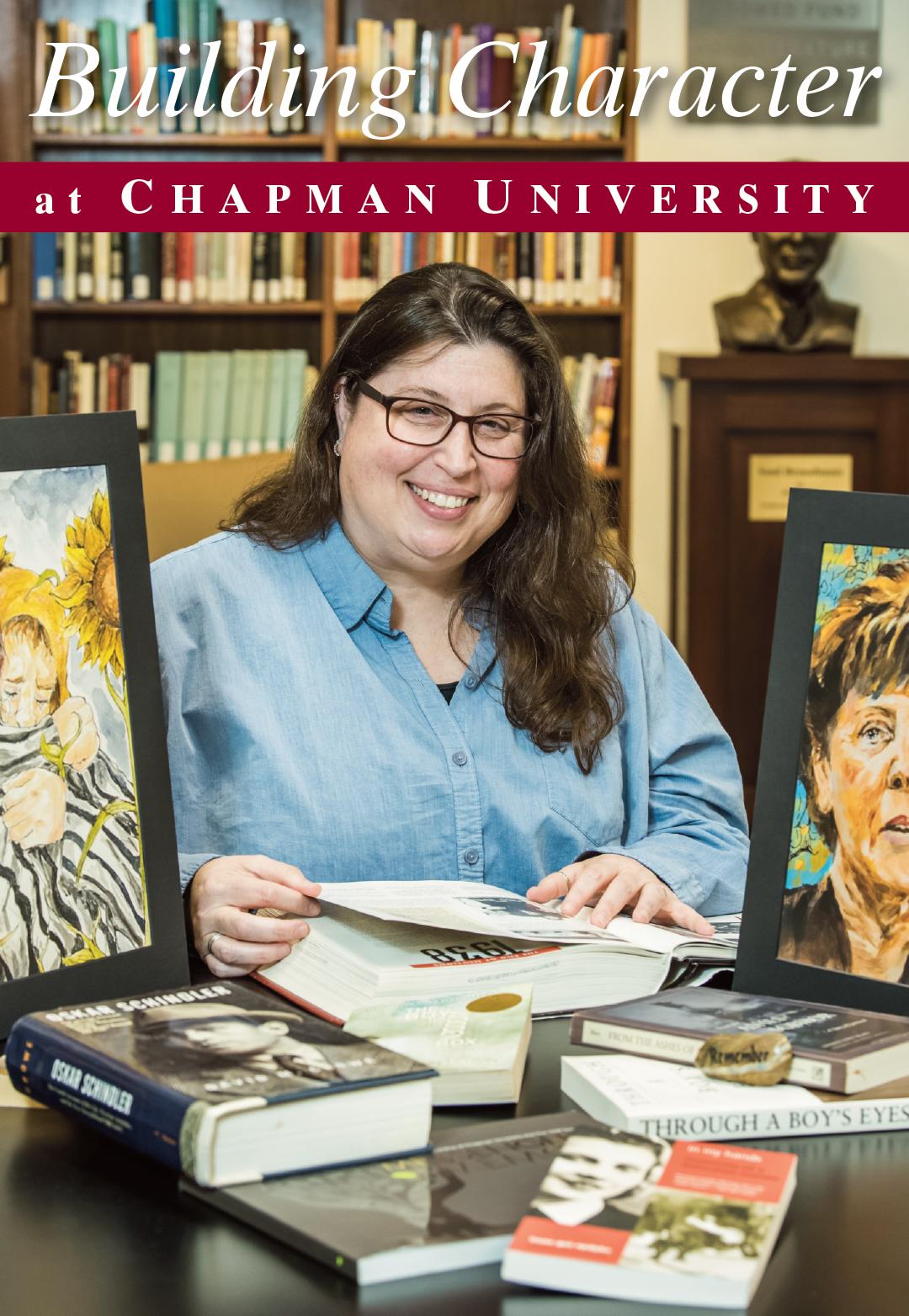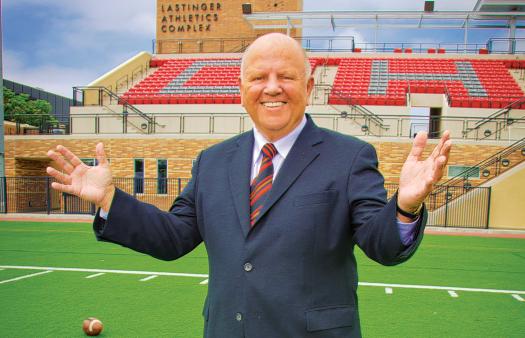
Jessica MyLymuk
During middle school and high school, Jessica MyLymuk made a yearly trip from her home in Las Vegas to Chapman University to attend the Strings Festival. While she enjoyed playing her violin for the judges at the weekend event, it was the campus’s warm and welcoming atmosphere that stayed with her.
“When it was time for college, I considered going to UC Davis or Cornell, but then I recalled Chapman’s beautiful and inviting campus, so I applied and was accepted,” says the Associate Director of the Samueli Holocaust Memorial Library at Chapman University who considers herself a “Chapman Lifer.”
“Though the campus has grown since the early 1990s when I became a student, Chapman remains a place where you feel a sense of belonging and community,” she says.
MyLymuk started college as a biology major but ended up changing to Religious Studies after taking a class on a subject that had intrigued her since middle school.
“When I was 12, I went to Yom HaShoah (Holocaust Remembrance Day) at Temple Beth Sholom in Las Vegas,” she says. “It wasn’t our usual Friday night service, and I didn’t want to go. The guest speaker was Irene Gut Opdyke, a Polish nurse who risked her life to save 12 Jewish people from persecution by the Nazis. After the war, she was honored as a Righteous Among the Nations by Yad Vashem.”
Introduction to the Holocaust
Up until that time, MyLymuk didn’t know anything about the Holocaust. Though her parents forced her to attend the event, she ended up fascinated by Opdyke’s talk.
“After Irene finished speaking, I had so many questions,” she says. “As a teenager, the Holocaust was incomprehensible. From that point on, I read everything I could about that time in history and the subject became a personal interest.”
It was in 1996 during her second year at Chapman while looking for electives that she decided to take an introductory course in the Holocaust, a class taught by Marilyn Harran, PhD, today Director of the Samueli Holocaust Memorial Library and Rodgers Center for Holocaust Education.
“During the first class, I flipped through the syllabus and saw there were 11 books on the required reading list,” she says. “When I looked around the classroom, everyone else was older than me. Though I was incredibly intimidated, I was also excited, because I had found an expert who could guide me in understanding the Holocaust. When I saw that we would have Irene Gut Opdyke as a speaker, I took that as a sign to put my head down and get the reading done so I would have a chance to hear her speak again and ask her the questions I’d had since I was 12.”
Though the class was rigorous, she found it enjoyable and enlightening. “Everyone was so engaged, and the conversations were rich and meaningful,” says MyLymuk, who ended up taking all of Harran’s classes and changing her major to Religious Studies with a second major in English with a teaching preparation breadth.
She took many Religious Studies classes with fellow student Rev. Dr. Sarah Halverson-Cano, who today is pastor at Irvine United Congregational Church.
“Jessica and I attended classes together, engaged in many conversations and generally had a delightful time growing in the most formative years of our lives,” says Halverson-Cano. “Every Tuesday and Thursday, we waited outside of Dr. Harran’s office to talk to her. We loved her classes, even though they were among the hardest, and we reveled in our hard-earned As.”
Harran ended up becoming MyLymuk’s advisor, and when graduation approached asked her what she planned to do.
Joining Chapman
“At the time, there was only one graduate program on the Holocaust, which was a PhD at Clark University in Massachusetts, but I didn’t feel ready,” she says. “Dr. Harran had been approved to hire an assistant and suggested I apply.”
MyLymuk was hired in 1999 and has worked alongside her mentor ever since. In 2006, she earned her Master of the Arts in Education, focusing on Curriculum and Instruction with the intention of teaching in the classroom. But she eventually concluded she would do her best work preparing teachers to instruct on the Holocaust.
“It is a difficult topic to teach students, and teachers appreciate some guidance,” she says. “As Holocaust research grows and changes, so does how we teach about it. For example, there has been a shift from focusing on the documentation and photographs that portray this history through the perspective of the perpetrators to listening to survivor testimony and learning from survivors, those who directly experienced these events. We also see a reclassification of the group formerly called “bystanders” as we acknowledge that inaction is really a form of action. Irene saw something wrong and did something about it. The lesson is to be aware and have the strength of self to do what needs to be done.”
The Rodgers Center presents an ongoing lecture series and annual events for members of Chapman and the public. They include An Evening of Holocaust Remembrance, a commemoration of Kristallnacht, and the Holocaust Art & Writing Contest, now in its 25th year.
Co-sponsored by The 1939 Society, the Art & Writing Contest is open to public, parochial and private middle and high schools. Students share their creative work, including essays, poetry art, and short films, in response to survivors’ oral testimonies. There is an awards ceremony and reception, where students meet survivors.
Power of Personal Connection
“The writing contest is so powerful, because it provides a personal connection for the students, like Irene provided for me,” says MyLymuk, who estimates the contest reached 8,000 students this year. “Spouting statistics isn’t effective. Students have a hard time grasping that 1.5 million children were murdered. But they can understand and be moved by one story at a time. Those who attend the ceremony and reception find the experience impactful and are completely engaged. They understand this is likely an opportunity they won’t have again.”
According to Harran, the educators who participate in the art and writing contest consider MyLymuk the “go to” person. “In many ways, Jessica has become the ‘face’ of the contest, as well as other aspects of the Center’s work,” she says. “From the start, I saw both dedication and excellence in her. It was evident to me she had a special passion for learning about the Holocaust and especially for connecting with survivors and their experiences. I attribute much of the success and growth of the Center to Jessica and our other exceptional staff member, Ashley Bloomfield.”
Halverson-Cano agrees regarding MyLymuk’s contributions. “Jessica’s creativity, commitment and fidelity to Dr. Harran’s vision and their shared desire to keep stories alive has kept the Rodgers Center at the forefront of Holocaust studies.”
Recently, MyLymuk decided it was time to further her knowledge on the Holocaust, so she applied and was accepted to the PhD program in Holocaust and Genocide Studies at Gratz College in Pennsylvania. (She won’t need to leave Chapman or her wife, Steph MyLymuk, or son, Seth, to attend, though. She will be taking the courses online in the evenings.)
“It is very exciting and rewarding to see Jessica embark on a new phase of her career as she begins a PhD program which will prepare her to become even more of a leader in Holocaust education,” says Harran.
- - - -
The Samueli Holocaust Memorial Library is located on the 4th floor of Chapman University’s Leatherby Libraries and is open to the public Monday-Friday from 9 am to 5 pm. Information: www.Chapman.edu/research/institutes-and-centers/holocaust-education/samueli-holocaust-memorial-library. Rodgers Center: www.Chapman.edu/research/institutes-and-centers/holocaust-education/rodgers-center.



